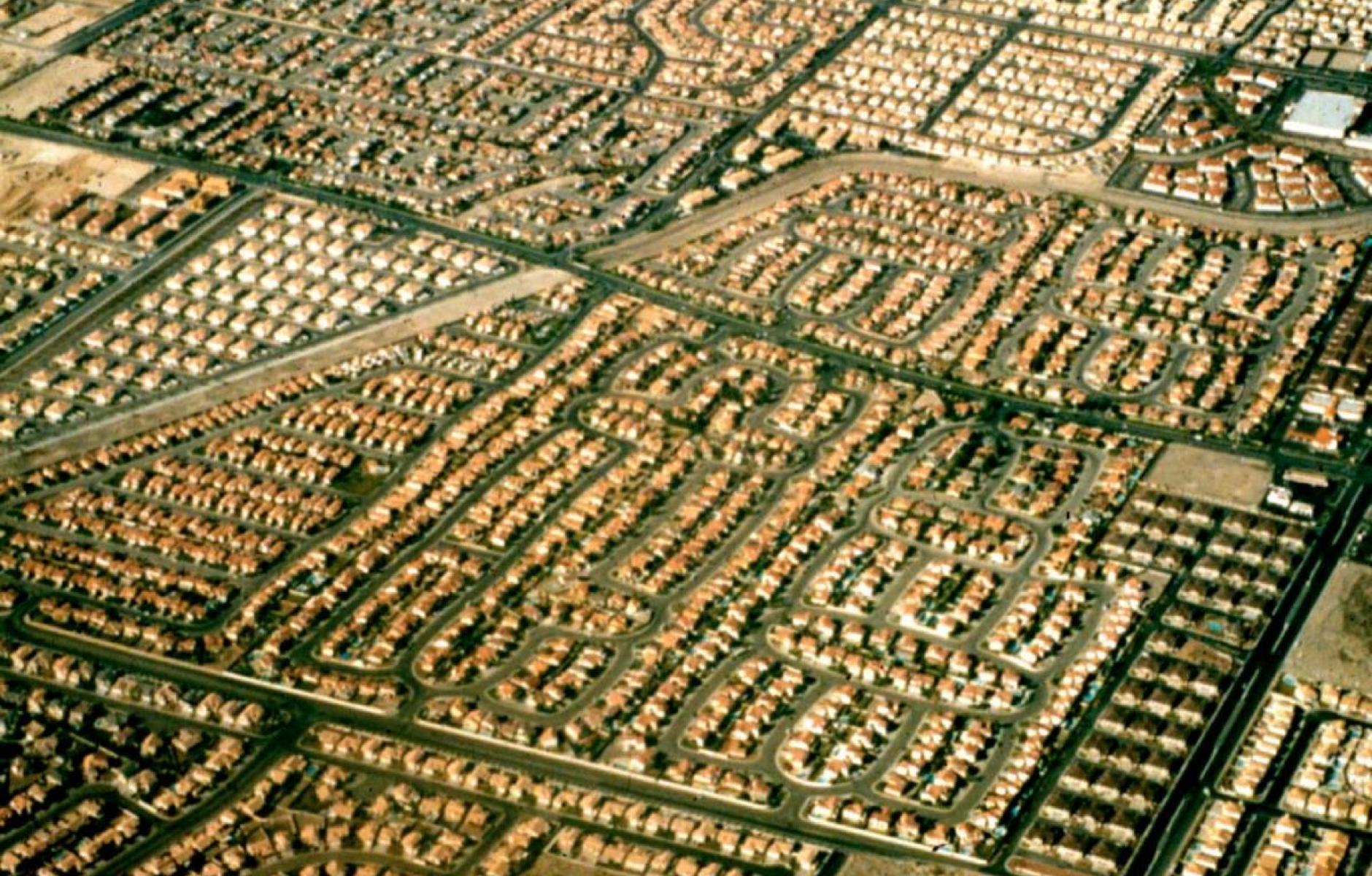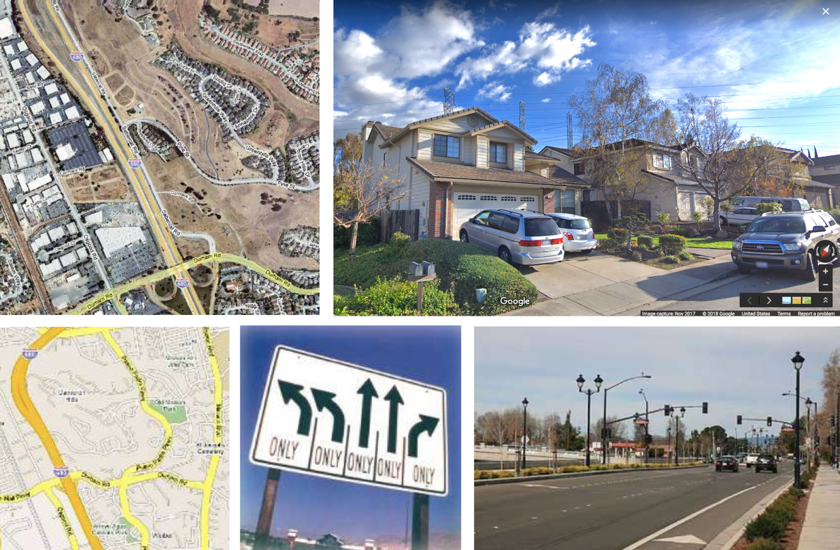
Reconfronting sprawl: Still paved with good intentions and asphalt
Note: This is Part 1 of a two-part series that was written for Doug Kelbaugh's upcoming book THE URBAN FIX: Resilient Cities in the War against Climate Change, Heat Islands and Overpopulation, due out in April of 2019.
No one better reveals the problems of sprawl than David Owen in his precocious, now classic 2004 article “Green Manhattan” in The New Yorker. “If you made all eight million New Yorkers live at a density of my town, they would require a space equivalent to land area of the six New England states, plus Delaware and New Jersey.” Edward Glaeser follows up in Triumph of the City: “We are a destructive species, and if you love nature, stay away from it. The best means of protecting the environment is to live in the heart of a city.”[i]
Suburbia first manifested itself in London in the 19thC, but the modern suburb as we know it started in the US after World War II. It has spread like a virus ever since, especially in North America, Australia, and parts of Europe. With the private automobile promising independence for every household, it was an unspoken assumption that American cities would spawn suburbs, and that the public sector would provide the infrastructure while industry provided the cars. There were not only federal subsidies for roads and sewers, but federal mortgage programs for returning war veterans that subsidized ownership of single-family homes, rather than rental apartments. Because rental units were much more common in cities than suburbs, the programs heavily favored what soon spread into concentric rings of leap-frog sprawl. Indeed, the suburban home surrounded by a private yard and with a car or two parked in the driveway or garage became the American Dream.[ii] In addition to tax breaks for mortgages and farm land, gasoline was directly and indirectly subsidized by government tax policies. Racial discrimination and better suburban schools added to the “white flight” to these bedroom communities.
No one has been more damning of the American suburb than Jane Jacobs, who over a half century ago savaged the often saccharin attitude toward the natural land that surrounds our cities: “It is no accident that we Americans, probably the world’s champion sentimentalizers about nature, are at one and the same time probably the world’s most voracious and disrespectful destroyers of wild and rural countryside. … It is neither love for nature nor respect for nature that leads us to this schizophrenic attitude. Instead, it is a sentimental desire to toy, rather patronizingly, with some insipid, standardized, suburbanized shadow of nature. … And so, each day, several thousand more acres of our countryside are eaten by the bulldozers, covered by pavement, dotted with suburbanites who killed the thing they thought they came to find.”[iii] And Austrian-born architect Victor Gruen, the inventor of the modern shopping mall, quickly came to condemn its impact in 1978 as “land-wasting seas of parking.”[iv] These two defects have only gotten worse since their frank and harsh pronouncements. It’s tragic that America not only smeared the suburban compromise of town and country across its 50 states, but it also exported it a world only too happy to embrace the seemingly happy lifestyle they’d seen in the movies and on TV.

Figure VIII.1 – Sprawl American style, with its over-equipped McMansions on cul-de-sac plumes, single-use zoning, dispersed road and utility infrastructure, with frustratingly long red lights because the gargantuan intersections are spaced too far apart in a coarse network that requires signalized left turn lanes. Some clever archeologist in the future will dig up a suburban intersection and realize that this civilization was plagued by too few places to turn left. As urbanist Leon Krier has said, “The very great challenge of the future … will be the urbanization of suburbia, the redevelopment of sprawl.” (image collage by M. Mehaffy)
These policies and practices have continued into the 21st Century. As real estate developer and fellow student of Buddhism Jonathan Rose points out in The Well-Tempered City:“From 1970 to 2015 the size of the average home in the US doubled, as did the number of cars, and its number of televisions has tripled, all this while the number of occupants per home halved!”[v] And even these ballooning houses were not big enough for the consumptive lifestyle that suburbia allowed and encouraged: Americans on average now rent over 5 sf in a storage unit on some forlorn arterial strip. The typical house in the contemporary American suburb “is estimated over a forty-year life cycle to use a staggering 15,455 GJ (Gigajoules) of energy. That amount of energy is enough to traverse the U.S. by automobile more than a thousand times.”[vi] Immense suburban lawns are both the pride and the burden of McMansions, surrounded by fenced backyards, generally useless side yards and manicured front yards. “In suburbia, you see no one doing anything in their yard other than working on it … its purpose is to be taken care of.”[vii] As the author Michael Pollan says “Lawns are the largest irrigated crop in America ... the area in lawn in this country is three times as big as the corn crop.”[viii] Other than mowing it, Americans spend no time in the front yard, which is beautifully maintained as a symbolic space, but too exposed to public view for relaxation. Pollan goes on to say that a Martian would wonder why no one spends time in their expansive front yard, while squeezing their outdoor activities into the back yard?
The US has more shopping malls than high schools, and retail consumption accounts for 80 percent of its economy.[ix] No longer just machines of consumption or bedroom communities, suburbs now have numerous workplaces, most notably office parks. The famous architect Rem Koolhaas describes these campuses as “a bland suburban environment that is becoming increasingly exclusive, its tech bubbles insulated from the public sphere."[x] These commercial islands of free-standing office blocks surrounded by parking are connected by rivers of asphalt with oceanic intersections, to allow multiple left-turn lanes, which make the red lights seemingly interminable. “It’s estimated that there are three nonresidential parking spaces for every car in the United States. That adds up to almost 800 million parking spaces, covering about 4,360 square miles, an area larger than Puerto Rico. In some cities, like Orlando and Los Angeles, parking lots are estimated to cover at least one-third of the land area, making them one of the most salient landscape features of the built world.”[xi] This is the land of big asphalt, which absorbs solar radiation and creates heat islands even in low-density suburbia.
The preferences of transit-inclined Millennials, who were born between 1980 and roughly 2000, are causing angst in traditionally car-dominated suburbia. “Suburbs nationwide have long lured companies—and the high-skilled workers they seek to attract—with good schools, relatively low crime and spacious corporate campuses surrounded by vast parking lots near major highways. A realization is growing among those communities’ business and civic leaders that the traditional suburban brand needs an overhaul.”[xii] For example, the inescapable suburban shopping mall is finally being retrofitted or displaced by street-oriented retail shops, but only after killing many stores in the host city and spawning nearby bottom-feeding outlets, all floating within a sea of parking. “Drenched in cafe-au-lait stucco, the mall was bordered by an example of America's most unique architectural contribution to the world, a parking lot. Some bemoan the brutalism of socialist architecture, but was the blandness of capitalist architecture any better? One could drive for miles along a boulevard and see nothing but parking lots and the kudzu of strip malls catering to every need…each one an advertisement for the pursuit of happiness.”[xiii]
Nonetheless, some Millennials are starting to leave cities for suburbs, where housing is usually more affordable and there are yards for their kids. But according to MIT’s Alan Berger, they want a different kind of suburbia: “They want breathing room but disdain the energy wastefulness, visual monotony and social conformity of postwar manufactured neighborhoods. If new suburbs can hit the sweet spot that accommodates the priorities of that generation, Millennial habitats will redefine everyday life for all suburbanites, which is 70 percent of Americans. … Climate will determine how environmental goals can be achieved in a given place: solar in the Sunbelt, say, or advanced water management in the rainy regions like the Pacific Northwest. … In sustainable new suburbs, house and lot sizes are smaller — in part because driveways and garages are eliminated — paving is reduced up to 50 percent and landscapes are more flexible. The plant-to-pavement ratio of the contemporary suburb is much higher than that of cities, but the next generation of suburbs can be even better at absorbing water.”[xiv] Drone deliveries, ride-sharing, car-sharing, AVs that park themselves and connect to house lights and thermostats will be commonplace, as will up to a 50 percent reduction in paved area. Less hardscape won’t be difficult, given the absurdly wide streets in contemporary subdivisions. There will be fewer fences and more common land for recreation, gardens, ponds, woods and wetlands.
These new suburbs will also tend to have welcome, summer air temperatures than cities, but they will still consume land, resources and energy at a faster per capita rate, although there will be fewer trips by gasoline-powered vehicles. In a study of urban spatial structure and heat waves across more than 50 large US cities, Brian Stone found the frequency of extreme heat events to be rising faster in sprawling cities than in compact cities.[xv] Nonetheless, suburbs’ carbon contribution per person remains worse than cities: With over half of its residents living in suburbs, 5 percent of the world population and 30 percent of the automobiles, the US astoundingly emits 45 percent of global transportation CO2emissions.[xvi] This amounts to 9 times its share! Because the auto-dependence in suburbia is acute and pervasive, it tends to cancel any climate benefits that accrue in the core city. “Dominated by emissions from cars, trucks and other forms of transportation, suburbs account for about half of all household GHG emissions in the United States.”[xvii] Cars are the biggest culprit in the dispersion and fragmentation of our cities. To quote David Owen again, “…cars have defined our culture and our lives., car is speed and sex and power and emancipation. It makes its driver a self-sufficient nation of one. It is everything a city is not.”[xviii]
Suburb’s egregious contribution to both urban heat islands (UHIs) and CC is precisely why suburban development—that agonizing American compromise between urban and rural—should be stubbornly resisted in developing countries. Unfortunately,cities are exploding in population and area, usually leading inadvertently toward huge metro areas. These megalopolises often struggle to keep up with infrastructure and services for economic productivity, quality of life and self-fulfillment for their residents. “For LUS (Large Urban Systems) development, the financial, political, environmental and social costs, challenges and implications are increasingly prohibitive for cities. Cities must devise innovative ways to collaborate on LUS by taking advantage of economies of scale, resource and institutional capacity-leveraging and other regional assets and opportunities.”[xix]
The huge conurbations of the Global South—from Mexico City, Lagos, Cairo, New Delhi to Bangkok and Shanghai—are spreading out into their hinterlands at an alarming speed. High land costs and ensuing gentrification are forcing workers to live up to three hours from the central cores of the cities, with onerous commutes that require multiple transit legs. Long commute times are not unknown in the US. “In a large, continuing study of upward mobility based at Harvard, commuting time has emerged as the single strongest factor in the odds of escaping poverty. The longer an average commute in a given county, the worse the chances of low-income families there moving up the ladder. … The relationship between transportation and social mobility is stronger than ... crime, elementary-school test scores or the percentage of two-parent families in a community …”[xx] This finding would likely surprise many an urban planner, municipal official and politician.
Humans may be living in a world that is over 50 percent urban and Americans in a country that is 80 percent urban, but in fact much of the urbanized area is actually suburban. Despite seeing a return of residents and offices to central cities in the US, especially older ones with a surplus of housing stock, “most of the population growth in the US is again happening on the fringes of fast-growing metro areas in the South and West.”[xxi] The growth is in both land area and population. Even though metro areas make up just 3.6 percent of the total size of the 48 contiguous states, 80 percent of Americans reside there. The metro areas are expanding by an average of about 1 million additional acres a year—the equivalent of adding the area of Los Angeles, Houston and Phoenix combined. US metro areas have grown fourfold since WWII. On a percentage basis, urban creep outpaces growth in all other land-use categories combined.[xxii] While many large cities in the US grew faster than their suburbs between 2000 and 2015, in the subsequent two years the suburbs outgrew cities in two-thirds of America’s large metropolitan areas, according to demographer William Frey of the Brookings Institution. “Fourteen big cities lost population in 2015—16 compared with just five in 2011-12—with Chicago, the nation’s third-largest city, hemorrhaging the most people.”[xxiii] Once again, American suburbs are growing, leaving open the question of whether sprawl or urbanism will be the dominant paradigm.
[i]Edward Glaeser, Triumph of the City,
[ii]David Owen, “Green Manhattan,” The New Yorker, 10/18/04
[iii]Jane Jacobs, ibid, p. 445
[iv]Leigh Gallagher, ibid, p.48
[v]Jonathan Rose, The Well-Tempered City, 2016, p. 341
[vi]Steve Kieran, “Scaling Regionalism,” Energy Accounts, 2017
[vii]David Owen, “Green Manhattan,” The New Yorker, 10/18/04
[viii]Michael Pollan, “An odd and completely unnatural institution, why is the front lawn so beloved by Americans?” Video on Aeon, 2017
[ix]Kennedy Smith, oral plenary presentation, CNU27, Savannah, 2018
[x]Rem Koolhaas, “My thoughts on the smart city,” 9/24/14
[xi]NY Times, 2/25/12
[xii]Katharine Shaver and Bill Turque, “Suburbs such as Montgomery County rethink transit to court millennials,” Washington Post, 3/29/15
[xiii]Viet Thanh Nguyen, The Sympathizer, 2005
[xiv]Alan Berger, “The Suburb of the Future, Almost here,” NY Times, 9/15/17
[xv]Raven, J., et al., ibid, p. 147
[xvi]“Cities, traffic, and CO2,” Conor K. Gately, Lucy R. Hutyra, Ian Sue Wing, Boston U., Ed. by Susan Hanson, Proceedings of the National Academy of Sciences, 3/13/15
[xvii]Urban design studio report, UC Berkeley, 2014
[xviii]David Owen, ibid
[xix]Jerry Kolo, “Lessons from Cities in the United Arab Emirates for the Development of Large
Urban Systems,” Iglus Quarterly, July, 2017
[xx]M. Bouchard, “Transportation Emerges as Crucial to Escaping Poverty,” NY Times, 5/7/15
[xxi]Ben Bolgar, “Train architects to help resolve the great crises of mass migration,” The Architects’ Journal, 7/18/17
[xxii]Dave Merrill and Lauren Leatherby, “Here’s How America Uses Its Land,” Bloomberg, 7/31/18
[xxiii]Richard Florida, "The Urban Revival Is Over," NY Times, 9/1/17




